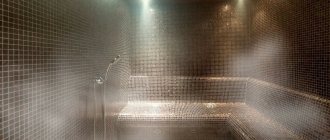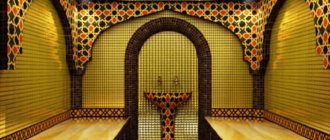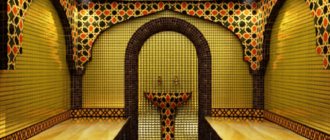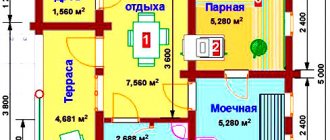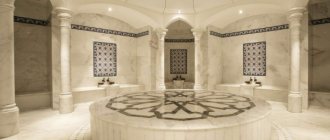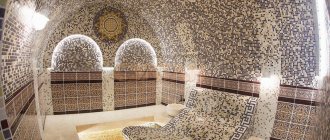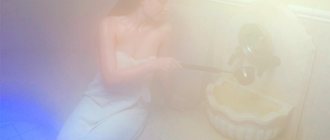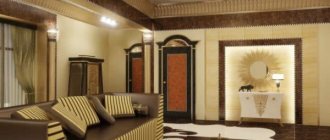It is impossible to imagine a real Turkish bath without a special bowl for ablution, which is called a kurna. A kurna is not just a bowl from which water is drawn for ablution, it is a necessary and obligatory attribute of the interior of a Turkish bath, without which one cannot imagine a real classic hammam.
If for a Russian bath a wooden tub or an ordinary basin with water is quite enough, then it is simply impossible to imagine a hammam without a kurna, usually made in an original design. In a real Turkish bath, everything must correspond to true oriental traditions and a special unique flavor.
And although in a modern hammam many mandatory attributes have long been replaced by more technologically innovative elements, such as steam generators or a lighting and ventilation control system, the kurna still remains one of the main and indispensable attributes of a Turkish bath.
What is kurna?
One of the most important attributes of the Turkish hamam is the kurna. This is a vessel intended for washing those in the room. Most often located in the center of a large hall, it is a kind of bowl in which cold water is mixed with hot water. Water is supplied using connected equipment, invisible to the eyes of visitors. Only two taps are visible, which can become a striking design element. The most impressive look is the beautiful marble kurna, from which water flows evenly from all sides. Designers, to create more oriental flavor, use qurna lighting.
The origins of the ancient tradition
Baths appeared in Turkey at the beginning of the 7th century. According to historical data, a special culture of ablution was adopted from the Arabs, who borrowed technology from the ancient Romans. According to the research of historians, the Roman baths served as the prototype for the hammam.
Read also: Exercises with rope for CrossFit
Baths began to gain popularity with the advent of Islam in eastern countries. There have been cases where ancient temples of other religions were converted into “hammams”. The premises were completely refurbished according to multi-stage procedures, and the thermal baths were improved for individual bathing in the Turkish style.
Turkish bath - hammam. Construction... Compact small hammam in an apartment... Turkish bath Hamam “De-Luxe... Hammam project - HeatMaster | Hama...
Hammam - Turkish bath: benefits and harms of... Do-it-yourself hammam - Building a hammam... Building a hammam bath with your own hands... Building a hammam bath with your own hands...
Requirements for a hammam kurna
Kurnas can be different in shape, size, design and material of manufacture, but their high quality must be equally high.
Requirements for kurns
- increased resistance to different temperature conditions of the steam room;
- no sharp corners or chips;
- environmental cleanliness;
- moisture resistance;
- tightness;
- aesthetics;
- safety.
The best materials for making vessels for washing the body in the hammam are marble and onyx. They satisfy all the requirements that the highest quality products must meet. You can complement the exquisite design of a bowl-shaped marble or onyx vessel with mosaics or frescoes.
Mistake #7 - weak steam generator
A steam generator that is incorrectly selected for power will slowly pump steam into the hammam and will not be able to maintain the required level of humidity in the steam room. There are two types of steam generators: electrode and heating element. Electrode steam generators are expensive, which is why heating elements are more popular.
Construction of a heating element steam generator for hammam
Electrode steam generator device for Turkish bath
A heating element is a tubular electric heater that operates on the principle of a boiler. The water boils, evaporates and flows through pipes into the hammam.
The power of the steam generator is selected depending on:
- steam room volume;
- availability of ventilation;
- material for making walls.
The best advice on how to avoid mistakes when building a hammam and choose the right steam generator is to contact specialists. Engineers will calculate the required power for your premises and help you make the right choice.
Hammam for bronchitis and varicose veins
People who have suffered such a serious illness as bronchitis can visit the hammam only during the recovery stage. Again, pay attention to your body temperature before visiting. If it’s elevated, give up this idea. If the temperature is normal, before hararet, drink plenty of tea with medicinal herbs: thyme, chamomile, licorice.
Breathe in the humid air of the steam room as deeply as possible so that the steam penetrates the lungs, this will help quickly get rid of mucus in the respiratory tract
Avoid cool showers or swimming pools to avoid relapse of the disease.
If you have varicose veins, alas, the hammam is contraindicated for you. The thing is that the intense heat of the steam room dilates blood vessels and stimulates blood circulation, and this puts a lot of stress on the blood vessels. Even if someone advises you to visit the steam room “correctly” if you have this disease, don’t listen. And this applies not only to the hammam, but also to the sauna and Russian bath. It's a pity, but there's nothing to be done about it.
How does the bathing ritual take place?
Once inside the Turkish hammam, you first warm up in a warm dressing room with a temperature of 35–45 degrees.
We suggest you read: How to dig a well if groundwater is close
Then go to the steam room, the temperature in which reaches 55–60 degrees. There you lie down on marble loungers and completely steam your body. The main condition for a successful visit to the hammam is to sweat well!
After this, it’s time for beauty treatments and massages, for which Turkish baths are so famous.
Read also: Why make your bed every morning
Peeling is traditionally carried out with a special rough glove; it exfoliates the skin in the same way as the inhabitants of the Ottoman Empire did long before our days. The hammam worker will treat every cell of your body, and you will definitely feel reborn!
They say that peeling in a Turkish bath can be a little painful, but then you get used to it and even enjoy the sensations. After the procedure, you may feel a slight tingling sensation for several hours.
Turkish massage is performed on a heated marble slab after relaxing and steaming the body. It should be hot and wet. The relaxing effect of Turkish massage is incomparable to any other type!
They leave the hammam after visiting three pools in turn, starting with one filled with warm water and ending with cold one. After this, bathers find themselves in a cool room. It is necessary to neutralize your body temperature before going outside.
The last one is the rest room. There you can have a pleasant time, sipping delicious drinks while sitting on a soft, cozy sofa.
Where is the best place to install a kurna?
Usually the kurna is mounted on a wall, in a corner, or placed firmly on the floor on a special podium. The choice of kurna design is determined primarily by the wishes of the customer, the design and capabilities of the designed hammam.
Although the ideal place to install the kurna would be the central part of the steam room, where it would be freely accessible to all visitors to the hammam.
For small rooms, a corner or wall option for installing a kurna is more suitable, which will significantly save space. In these cases, a convenient option would be to install a small vessel with taps into the wall.
According to classical eastern canons, the hammam should consist of 5 steam rooms according to the number of fingers of the palm. One kurna is installed in each of the steam rooms. A small but orientally elegant fountain will be a pleasant addition to the kurna. Remember the “Bakhchisarai Fountain”, these are the small fountains you can decorate your hammam with.
To ensure that you are not disappointed in the future by the option of placing the main attributes of the hamam, when designing a Turkish bath, we advise you to immediately contact experienced specialists who will help you make optimal use of the available space, so that later you do not have to waste time and resources on remaking a poorly designed hamam.
The classic qurna does not have a drain hole, so the water that fills the bowl simply overflows into a bizarre waterfall.
Taps for filling the kurna with hot and cold water, as a rule, also try to be made in a single oriental style, which are often made of metal.
Features and species diversity of kurnas
Traditionally, kurnas in Turkish baths were made of marble. Today, this requirement is no longer entirely mandatory due to the high cost of marble and the availability of more technologically advanced and less expensive modern materials. A budget version of the kurna can even be made using concrete.
Quirnas are often carved from stone or various types of minerals, decorating them with elaborate carvings. In addition to marble, the best option would be onyx and travertine, which are distinguished not only by high aesthetic properties, but also have high hygiene and safety during operation, since they do not emit any harmful substances under the influence of high temperature and high humidity.
The budget option involves making kurnas from stone or marble chips, faience and other cheaper, but no less safe materials.
Kurnas made of metal will look very elegant. Most often they are made from copper-containing metals and alloys: copper itself, brass and bronze. Such kurnas will not only satisfy the tastes of true connoisseurs of beauty and grace, products made from these materials also have bactericidal properties. They retain their noble aesthetic appearance for a long time and easily fit into the luxurious interior of a modern Turkish bath.
Qurna can have any shape, but usually the manufacturers of these products try to comply with certain eastern canons when making it. As an option, you can order delivery of the finished qurna directly from Turkey, or you can turn to famous domestic craftsmen who use classic oriental sketches to make it.
The color of the qurna can also be anything from light to black, the main thing is that it pleases the eyes of its visitors and fits harmoniously into the interior of the hammam itself.
Walls
Insulation of walls in a Turkish bath
The best option for a hammam is brick walls or foam blocks. Brick, like other materials, must be solid, since it will serve as an attachment point for the thermal cake structure. Voids in the walls will not provide the required fixation and proper fastening reliability.
Extruded polystyrene foam panels are attached to the walls. They even out all the unevenness and roughness. Among other advantages, panel laying is a waste-free production - the trimmings can be used for their intended purpose in other places. For interior decoration, 50 mm plates are used.
If the wall is brick or concrete or made of foam block, then:
– First of all, the surface is thoroughly primed;
– then the installation of expanded polystyrene panels with two-layer reinforcement begins. The fixing agent is tile adhesive designed for working with polymer materials. To ensure reliable fastening, use self-tapping screws with washers (7 pieces per 1 m/sq.m. in a checkerboard pattern);
– the panels are fastened together with foam adhesive for polystyrene surfaces.
Materials and equipment for the hammam may vary. For example, there are steam rooms with wooden products, or there is a need to install a partition made of wood. In this case:
- An additional frame is created from concrete or brick walls (or foam blocks) are laid out. In this case, the structure becomes significantly heavier, which means preliminary strengthening of the foundation is necessary. The masonry should not be adjacent to the wooden wall; between them it is necessary to leave space for an air cushion. Laying bricks or foam blocks is carried out in strict accordance with building codes.
- To fasten the panels, you will need to install guide profiles. It is done in the same way as for installing plasterboard sheets. The panels are installed with the reinforced side in the steam room and the non-reinforced side against the wall. They are fixed to each other with an adhesive composition for polymer materials. Traditionally, the fixation is strengthened with self-tapping screws and washers, only in this case 8 pieces are used for each m/sq. and also in a checkerboard pattern.
The steam room is completely covered with panels, including where the sun loungers are located. Otherwise, they will not be fixed properly, which means it will cover the bed.
The top of the panel touches the bottom edge of the dome, that is, the top part must be trimmed, exactly following the contour of the dome structure. If you have built an arch, envelope or skullcap, you will need to install a horizontal top end.
The heated floor rises along the wall to a height of 150 cm, except in the places where the seats are installed. To conduct thermal communications, special grooves are cut out in the panels, in which pipes and cables are laid (just not behind the sun loungers). The width of the channels must exceed the diameter of the laid lines by 10 mm. A pipe/cable is laid at the bottom of each, which is fixed so that the distance from them to the panels is 5 mm. This will eliminate the possibility of polystyrene foam melting from contact with a hot surface. The groove is filled with adhesive for reinforcement. After the glue has dried, the surface is reinforced with alkali-resistant facade fiberglass mesh with a density of 145 grams per square. Then reinforcing glue is applied again. At the final stage, we cover everything with waterproofing in three layers.
Don’t forget to waterproof the panel joints as well. In places where the floor and walls touch, as well as where the sun loungers are located, waterproofing tape is laid. Pasting begins from the corners, where strips 15-20 cm high are glued. Then we go along the entire perimeter of the floor covering. The tape is not self-adhesive, so it is necessary to use ceramic adhesive with a strong hold.
After this, you can begin decorating the walls with mosaics.
Mistake #4 – incorrect room dimensions
A Turkish hammam does not require a large area - it is more difficult to warm up and requires more steam to achieve the required level of humidity. Large dimensions are justified only when a massage table is installed in the steam room or the commercial use of the hammam is implied.
Marble massage table in a large Turkish steam room
Compact option for placing a massage table in a hammam
When planning a steam room, keep in mind that insulation, waterproofing, cladding and other materials take at least 4 cm from the room on each wall. And when the wall adjoins the street - at least 10 cm.
Lighting
Lighting devices operating in conditions of high humidity should be given special attention. Firstly, the maximum operating voltage should not exceed 24 V. Secondly, the degree of protection is at least IP64.
It’s worth noting right away that selecting lighting for a steam room is a painstaking task that requires certain knowledge and skills. The decoupling of electrical wires must be laid before the mosaic is laid.
You can choose ceiling or wall lighting fixtures. Some people just need the light coming from decorative elements, which include:
LED strips
LED waterproof strip for hammam.
Usually installed in sun loungers, on the ceiling, decorative wall cells. The light emanating from them is very beautiful, but the technical documentation for each LED strip indicates a maximum operating temperature of +40°C. This means that they will have to be changed frequently.
Starry sky
Starry sky for hamam
The shimmering sky can shimmer in white or red-green-blue. It all depends on your preferences, but keep in mind that installing the decoration is a labor-intensive process and requires proper placement of the projector installed in the next room. Be sure to provide easy access to it in case a light bulb suddenly burns out.
The projector is connected to fiber optic bundles that run under the dome structure. They are the ones who create the star effect. To do this, technological holes are made in the dome, from which the fibers protrude 10-15 cm. They are fixed with adhesive foam. Then the dome-shaped sphere is reinforced (if necessary), waterproofing is applied, a mosaic is laid, and the optical fibers are cut off at the root. You can install the starry sky yourself or with the help of a specialist.
The number of fiber optic bundles depends on the ceiling area.
This is all the information anyone who wants to buy a hammam needs to know.
Mistake No. 9 – incorrectly selected lamps
Hammam is not only a hygienic cleansing, but also a place of relaxation, where all the decoration should give peace and lead to harmony. To do this, it is important not only to choose the right color for the decoration and sun loungers, but also to properly organize the lighting.
Lamps in the hammam should not only be aesthetically pleasing, but also safe. Therefore, you need to choose only waterproof lamps with a voltage of 12 V and a degree of protection of at least IP 65.
Original lighting in the Turkish steam room
Typically, the lighting in the hammam is dimmed to create a relaxing atmosphere. But sometimes you want more light. Therefore, the best option is when different light zones can be turned on independently of each other. For example, you can separate the main lighting, the lighting of the sun loungers and the portal. Then you can adjust the brightness of the lighting in the steam room depending on your mood and the purpose of using the hammam.
Why do you need a tap in a bathhouse: a review of fittings for organizing bath water supply
Russian baths are famous for their special atmosphere, which surrounds lovers of bath procedures with gentle or vigorous steam. Both to create a specific aura of the steam room and for the washing process, one of the main bath components is needed - water. It can be “trained” in buckets, heated in a tank and scooped with a ladle, watering the heater and filling the bowls. However, it is much more convenient to lay a water supply and install a tap in the bathhouse, so that the process of preparing for visiting it does not tire the household, and during the hygienic procedure there is no threat of accidental burns and serious injuries.
The faucet is one of the oldest inventions of plumbing, serving as a water supply organ long before the global introduction of water pipes. In principle, we are still a long way from a comprehensive plumbing revolution. Many villages and holiday villages manage in the old fashioned way without highways transporting water. True, their farms, which have not been modernized, still have taps. Antique devices with spool and cork samovar mechanisms equip washstands, drinking water containers and bath tanks.
The operating principle of primitive plumbing fixtures is simple. A plug or spool locks and unlocks the flow of water. They are made in the form of a conical bushing or ball with a through hole along one of the horizontal axes. The handle of a simple faucet is rigidly connected to the plug and spool. We turned the handle 90º and opened the “channel” by installing a hole opposite both tap pipes. We returned it to its previous position and closed the water passage with a steel, cast iron, bronze or brass “barrel” of the critical part. The power of the flow can be controlled only by varying the angle of rotation. However, such a tap for a tank in a bathhouse is a completely suitable solution, because this is already a kind of mechanization of water supply.
Functional areas of the Turkish bath
The classic hammam, which became widespread in Turkey, Azerbaijan, Afghanistan, Iran, and Central Asia during the power of the Ottoman Porte, was often rebuilt from a Byzantine bath. Hence the similar layout with a vast central hall, from which emanate peculiar rays - small steam rooms in which different air temperatures are maintained from 35 degrees Celsius and there are objects in which it reaches 70 degrees, but this is more an exception than rule in traditional arrangement, and even in such a matter as visiting the hammam. Let's look at this in a little more detail:
- Entering the bathhouse from the street, the visitor immediately finds himself in the locker room, where it is relatively cool in summer and very warm in winter. The average temperature of this room rarely goes beyond 28 - 31 degrees Celsius. This is where the comfort zone begins and the visitor is greeted by the staff. If the bathhouse is small, and it is not possible to divide the area into men's and women's, this is simple. Even days are given to the stronger half, odd days to the beautiful half. At this stage, you can already find out that today is Women’s Day in the bathhouse; a jute rope will simply be stretched in the aisle. Here, all self-respecting establishments provide visitors with towels, soap and slippers with flat wooden soles;
- The heart of any hammam is the main hall of Sogolyuk. It is heated to 45 - 50 degrees, and heating occurs volumetrically. Both the walls and floor heat up. Naturally, the temperature of the surrounding air is perceived by marble benches, on which it is customary to lie with your legs slightly elevated above body level. In some places, it is customary to lay a cotton towel on the bench. As we mentioned above, in the main hall there is a pool of water to maintain high air humidity. On marble loungers, Chebek Tashi perform a set of procedures, massage, wraps, peeling and others. Moreover, this is done by specially trained people, highly specialized specialists. In old hammams, one could often see a large massive boulder with a smooth polished surface. It was actually called the “Belly Stone”. It was used for medicinal purposes. A well-heated mass relieved stomach and liver colic well. Naturally, the rounded shape of the surface ensured good contact with the patient’s abdomen;
- In the small steam rooms adjacent to Sogolyuk, different temperatures were maintained. For weakened patients and women it varied between 33 and 40 degrees, and for the true descendants of the Janissaries it reached 70;
- A mandatory attribute of the hammam was a swimming pool in the bathhouse; today, a shower is an equally integral element.
A few words about the microclimate. If previously large copper boilers in which water boiled were responsible for steam generation, now all modern designs are equipped with steam generators that generate steam under the strict supervision of processors, controllers and sensors.
Rules for conducting procedures
How to steam in a hammam, or rather, not just steam, but how to properly steam in a hammam? The chronology and order are as follows:
- In the locker room, the client leaves his clothes, acclimatizes, receives slippers for the bath, naturally with local flavor, and a towel. It is an important and indispensable attribute of the local tradition, since it is not customary not only for women, but also for men to be naked.
- After temperature adaptation, you can go to the central hall, where the body warms up completely within 15 - 20 minutes. During this period, the pores open and sweating begins. In large complexes, as we said, there are several steam rooms with different temperatures, which can be selected based on personal preferences. Small establishments make do with one steam room.
- After the first visit, you should take a shower and thoroughly wash off the sweat. After this, it is possible to take treatments in the bathhouse with a swimming pool.
- If the program is extended, then after warming up you can begin pleasant procedures. The rules for visiting the hammam determine that massage can be done only after the skin, muscles, ligaments and joints have been thoroughly warmed up. As a rule, the massage is accompanied by preliminary intensive rubbing of the body, for which a special Turkish kese washcloth is used. This is both a kind of peeling and additional heating, which provokes increased blood microcirculation in the peripheral vessels. In addition, it should be noted that a washcloth for a hammam is not a simple one. It is made using a special technology of weaving from camel, or less often sheep, wool. The massage session lasts about 20 - 25 minutes.
- After which you should take a shower and, after resting a bit, prepare for a soapy massage. For it, soap foam is whipped in a special square bag made of natural fabric. Getting excellent soap foam without certain skills is not easy, and hamam soap has a natural base. It includes olive oil, peach oil, jojoba oil. If a massage with a camel mitt was invigorating, then soap therapy is more likely to pacify and calm.
- Finally, the rules for visiting the hammam stipulate, after completing all the procedures, leaving the steam zone to the relaxation area, where the omnipresent and attentive staff will immediately offer tea, sherbet, soft drinks, and oriental sweets.
Hamam, the rules of visiting, which have been formed over centuries, cannot be rushed. As we noted above, very often a trip to the bathhouse in the East lasts for the whole day and turns into a kind of gentlemen’s club for men, and into a full-scale bachelorette party for women. Moreover, in Turkey, for example, a man is required to let his wife go to the bathhouse once a week without unnecessary conditions. From here, you can find the answer to the question of how often you can go to the hammam.
Indications and contraindications regarding the use of an oriental bath
In this section, we will consider the question of how to go to the hammam correctly so that the benefits of the procedures are maximized and the negative effect is minimized. Let's start with contraindications. Under what circumstances should you refrain from going to the oriental bathhouse:
- The presence of cancer and progressive benign neoplasms;
- Any exacerbation of chronic diseases;
- Skin diseases, including traumatic skin injuries two days old and new;
- Bleeding, including menstrual bleeding;
- High blood pressure.
As we constantly repeat, any bathhouse, even such a delicate one as a hammam, is a serious burden on the human cardiovascular system, therefore, to complete the clinical picture and prevent possible negative consequences, it is important to consult a doctor regarding the safety of going to an oriental bathhouse or the presence of any or restrictions on the quality or time of receiving procedures. Here, you can clarify the question of how often you can visit the hammam.
At the same time, in the set of rules on how to properly take hammam, there are certain recommendations for the treatment and prevention of some specific diseases, namely:
- Colds, at the initial stage, when the body temperature does not exceed 37.8 degrees Celsius;
- Treatment of infectious diseases of the nasopharynx;
- Recovery after sports injuries, high physical activity associated with overstrain of joints, ligaments, muscles;
- Prevention and treatment of stressful situations, restoration of psychological comfort;
- Increasing immunity, its restoration, after suffering infectious diseases, provided that there is no picture of the clinical manifestation of any complications, including hidden ones.
By the way! On some specialized Internet resources, when considering the question of how to use a hammam, the myth is actively exaggerated that while in the steam room of a Turkish bath, you should under no circumstances make sudden movements. They say that the body is well warmed up, the ligaments, joints, and muscles are well warmed up, and awkward movement is fraught with sprains, dislocations, and tears. In fact, common sense, logic and practice show that all of the above is typical in everyday life, when the body is not warmed up. The golden rule of any physical educator and professional athlete is: “If you’re not warmed up, don’t start.” Warm-up is a mandatory prelude to any workout, even low intensity. What can you do in the hammam to get a dislocated joint or a torn ligament? Unclear. Unless the massage therapist gets extremely angry. In any case, the bath practice of the East does not know such incidents.
Obviously, it is also necessary to note that countries professing Islam, in any religious movement, have a very negative attitude towards the consumption of alcohol, including low-alcohol drinks, in public places. The only exception is Turkish hotels, where the staff, trained by German owners, are quite imbued with European values and traditions, and the unfading principle: “Every whim for your money” has been exploited for a long time and extremely productively.
Faucets with ceramic discs
Disk devices are very similar to the previous cork type. Only instead of a plug, a ceramic module rotates in the tap, tightly ground to a stationary ceramic disk. Similarly, when the force applied to the flywheel is applied, the movable disk moves and when the holes on both ceramic parts coincide, the path for the jet opens.
A significant advantage of disk models is the reduced flywheel stroke and “sensitivity” to the slightest changes in position made to regulate the flow. Those. already at 9º turn a small stream will flow from the tap. The downside, again, is the “sensitive” design to the degree of water purification. The tap stopped holding water because it was clogged with grains of sand, so I ran to the store for a new mobile unit.
It is up to the owners to decide which water tap to choose for water supply to the bathhouse. From the description you can understand what is easier to use and what is easier to repair. The listed design features are repeated by mixers, which can also be used in baths with gas and electric water heating systems. Faucets are installed in showers and sinks, sometimes in kitchens if the building has a room with this function. But that is not all.
Why do you need a drain valve?
Drainage devices are required for the conservation of all types of autonomous water supply systems, i.e. for draining water from equipment and pipelines. The summer water supply system is preserved at the end of the summer season, the winter one every time the site is left for a long time. Install drainage devices:
- at the beginning of the outer line;
- in front of each device;
- before the water supply enters the building.
Now, instead of a conventional drain device, you can use a solenoid valve, which is controlled remotely. Once we’ve touched on the valves, let’s remember about the reverse options used to prevent the reverse flow of water. They are required before the pump.
These are not all plumbing tricks that facilitate the operation of the system and guarantee its trouble-free operation. We were talking only about cranes. We are sure that the zealous reader will answer the question “do you need a faucet in a bathhouse” in the affirmative?
Source of the article: https://tvoya-banya.ru/voda/zachem-nuzhen-kran-v-bane.html
Shut-off valves for autonomous water supply
The function of water shut-off devices is to shut off the flow in the event of a shutdown of a separate plumbing fixture or section of the system. When the water supply system is in stable operation, shut-off devices—valves—are installed in the “open” position. Close them if repairs are required.
- at the beginning of the outer part of the pipeline;
- at the entrance to the bathhouse;
- on each branch of the external and internal components of the water supply system;
- on a riser, if the building is two or more storeys;
- in front of each plumbing consumer: shower, toilet, sink, etc.
In baths with hot water supply, the cold and hot lines are equipped with separate valves.
In terms of design features, traditional water valves resemble faucets with retractable and non-retractable spindles. By analogy, their working unit can be with a movable or fixed rod. True, the valve can be attached to the stem in a floating manner using a ball attachment. Valves are available through passage, angle and direct flow. They are usually installed in less conspicuous places.
They are rarely used, and they are also repaired. Basically, all repair operations end with replacing the gasket or stuffing box. However, shut-off valves require regular maintenance, especially if they have a cast-iron head body and a steel rod. With rare use, these parts tend to “grow together”, which is why you will have to replace the entire module.




